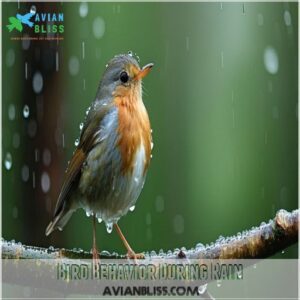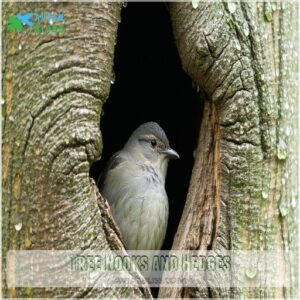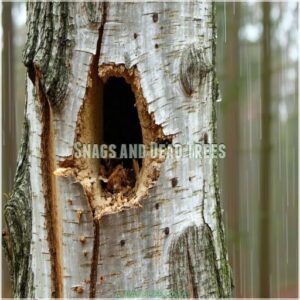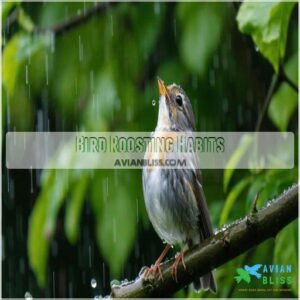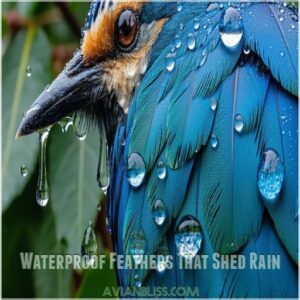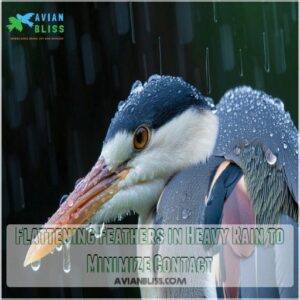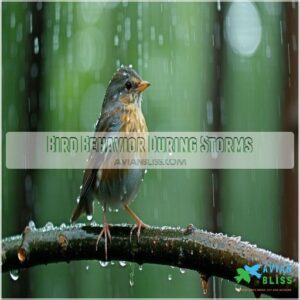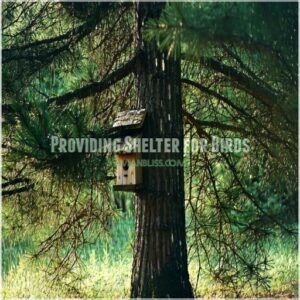This site is supported by our readers. We may earn a commission, at no cost to you, if you purchase through links.
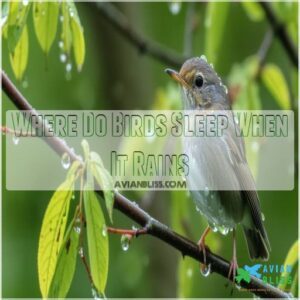
Cavity nesters, like chickadees, snuggle in their tree holes or cozy roost boxes.
Others, like sparrows, might find shelter under dense foliage.
Think of it like us humans finding a dry spot during a downpour—birds are resourceful!
Some even fluff their feathers for extra insulation.
Larger birds might brave the rain, but torrential downpours can be tough on everyone.
Want to know more about how different birds weather the storm?
You’ll be surprised by their clever adaptations.
Table Of Contents
- Key Takeaways
- Bird Behavior During Rain
- Where Do Birds Sleep When It Rains
- Types of Bird Shelters
- Bird Roosting Habits
- How Birds Protect Themselves in Rain
- Bird Behavior During Storms
- Challenges of Flying in The Rain
- Post-Rain Behavior
- Providing Shelter for Birds
- Creating Bird-Friendly Habitats
- Frequently Asked Questions (FAQs)
- What do birds do when it rains at night?
- Where do birds go during heavy rain?
- Do birds get cold in the rain?
- Do birds like it when it rains?
- How do urban environments affect bird sheltering?
- Do birds sing less during rainy weather?
- Can any birds predict upcoming rain?
- How do rainstorms impact bird mating rituals?
- Are there specific trees birds prefer in rain?
- Conclusion
Key Takeaways
- Birds are resourceful; they find shelter in tree nooks, dense foliage, or man-made roosting boxes when it rains, ensuring they stay dry and warm.
- They have remarkable adaptations, like fluffing feathers for insulation and using oils to create a waterproof barrier, allowing them to survive wet weather.
- Most birds adapt their behavior based on rain intensity, seeking cover during heavy rain, while ducks and waterfowl may thrive in wet conditions.
- Creating bird-friendly habitats like dense evergreens, brush piles, and roosting boxes in your yard provides essential protection for birds during rainy weather.
Bird Behavior During Rain
You’ll discover how birds protect themselves during rain by employing effective shelter strategies such as cavity roosting in tree hollows or birdhouses, while seeking shelter in tree nooks, hedges, and snags while maintaining their body temperature with specialized waterproof feathers.
Just like you’d take cover under an umbrella, birds have developed remarkable strategies to stay dry and warm, from fluffing their feathers for insulation to positioning themselves strategically against rain and wind.
Why Birds Seek Shelter During Rain
The survival instinct kicks in when rain starts falling, and you’ll find birds quickly seeking shelter. Their feathers, normally excellent insulators, can lose effectiveness when soaked through. This creates a pressing need for protection, especially in smaller birds who face a higher risk of hypothermia.
- Body heat escapes rapidly through wet feathers
- Smaller birds are particularly vulnerable due to their size
- Finding food becomes challenging in heavy rain
- Energy conservation becomes critical for survival
- Safe shelter spots are essential to prevent exhaustion
How Birds Adapt to Rainy Weather
Most birds possess remarkable adaptations for handling wet weather.
You’ll notice their feathers contain special oils that create a waterproof barrier, while tiny air pockets trapped between layers provide key insulation.
When birds need to find shelter, they’ll often look for dense foliage or tree cavities to stay dry and conserve energy.
During light rain, they’ll puff up their feathers to stay warm, but in heavy downpours, they’ll flatten them to shed water efficiently.
These adaptations help conserve energy and maintain a good body temperature, vital for survival.
Bird Species and Rain Patterns
Some birds, like the palm cockatoo with its striking smoky black mohawks, have evolved unique hairstyles for various purposes, including attracting mates and warding off rivals. Different bird species handle rain in unique ways.
You’ll spot ducks paddling happily through downpours, while tiny songbirds quickly seek cover.
Hawks and eagles often perch stoically in light rain, their dense feathers providing excellent protection.
During breeding season, rainfall patterns influence nesting choices – woodpeckers prefer areas with moderate precipitation, while desert birds time their breeding around brief rainy periods to maximize food availability.
Where Do Birds Sleep When It Rains
Birds don’t just wing it when rain clouds gather – they’ve got baby bird waterproofing strategies like water-resistant down feathers that help them stay dry and cozy. Birds don’t just wing it when rain clouds gather – they’ve got smart strategies for staying dry and cozy. You’ll find these feathered friends tucked away in spots you mightn’t expect, using their natural instincts to stay safe and dry.
During light showers, many birds simply puff up their feathers, creating a waterproof shield that keeps them warm and protected. They also adapt their flight techniques, such as flying in zigzag patterns, to handle turbulent air.
When heavier rain hits, they’ll seek out natural hideaways, often remaining motionless to conserve energy. Watch closely, and you’ll notice larger birds like crows positioning themselves to face the rain head-on, while smaller songbirds snuggle together in sheltered spots.
Even in the heaviest downpours, birds manage to catch some shuteye by finding protected perches where they can rest without getting soaked.
Types of Bird Shelters
You’ll be amazed to discover that birds have many more shelter options than just your backyard birdhouse when it rains.
From cozy tree nooks and dense hedges to natural cavities in dead trees and custom-built roosting boxes, these clever creatures know exactly where to find protection from wet weather.
Tree Nooks and Hedges
When it pours outside, tree nooks and hedges transform into nature’s umbrellas for our feathered friends.
You’ll spot these clever creatures tucking themselves into the V-shaped joints where branches meet tree trunks, or nestling deep within dense hedge networks.
These natural shelters work like tiny apartments, complete with overhead protection and windbreaks.
Think of them as cozy hideaways where birds can wait out the storm.
Snags and Dead Trees
Many snags and dead trees serve as nature’s high-rise apartments for birds seeking shelter from rain.
You’ll find these wooden sanctuaries dotting landscapes like natural skyscrapers, offering essential protection when storms roll in.
Here’s what makes snags perfect shelters:
- Natural cavities form perfect hideaways from rain and wind
- Loose bark creates cozy pockets for smaller birds
- Woodpecker holes provide ready-made apartments for multiple species
Rock Crevices and Brush Piles
Rock crevices and brush piles offer natural sanctuaries that work like miniature fortresses for our feathered friends.
You’ll find these shelters scattered throughout nature, providing safe spaces during downpours.
| Shelter Type | Benefits | Best For |
|---|---|---|
| Rock Crevices | Wind protection | Small songbirds |
| Brush Piles | Quick escape | Ground birds |
| Natural Caves | Year-round shelter | Multiple species |
Creating brush piles in your yard by layering branches and leaves offers birds instant protection from the elements.
Roosting Boxes and Birdhouses
Beyond natural hideaways, you’ll find birds seeking shelter in roosting boxes and birdhouses.
These cozy retreats offer protection from rain and predators, especially during harsh weather.
The best designs feature bottom-entry holes to keep rain out and rough interior walls for easy climbing.
You can boost their effectiveness by placing them 5-15 feet high in sheltered spots, away from prevailing winds and direct rainfall.
Bird Roosting Habits
When the sky opens up, birds display fascinating roosting habits that employ strategies like using tree cavities for shelter, such as woodpeckers and bluebirds seeking refuge in natural nesting sites. When the sky opens up, birds display fascinating roosting habits that even rainy weather can’t disrupt.
You’ll discover how chickadees, jays, and even ducks each find unique ways to cozy up and stay dry.
Cavity Roosters: Chickadees, Small Owls, Woodpeckers
Imagine a cozy hideaway: chickadees, small owls, and woodpeckers find these in tree cavities.
These birds flaunt clever cavity roosting adaptations to stay snug during rainstorms, and some even set up their nests with materials found in a chickadee nest rain arrangement.
They minimize predator risks and manage cavity roosting competition.
Like snagging the best seat at the movies, picking a prime nest site is their winter roosting strategy to guarantee warmth and safety.
Branch Roosters: Jays, Sparrows, Cardinals, Crows
Ever wonder where jays, sparrows, cardinals, and crows spend their nights?
These branch roosters, unlike cavity dwellers, find safety in trees, often within their preferred backyard bird habitats.
Their branch roosting behavior involves selecting sturdy branches, often hidden within dense foliage.
This offers protection from predators and the elements, particularly important during winter roosting sites.
Food gathering strategies often dictate roost location, near food sources.
Nest site selection influences future roost sites.
Clever birds!
Water Roosters: Ducks, Herons
Among waterfowl, ducks and herons have interesting rainy-day habits. Here’s how they stay cozy:
- Adaptations: Ducks thrive with waterproof feathers.
- Nesting: Herons find safe spots in dense wetlands.
- Rainy Meals: Both enjoy bountiful food as rain stirs up aquatic treats.
- Pond Perks: Rain fills ponds, creating vibrant ecosystems.
Such adaptations keep them content in wet weather!
How Birds Protect Themselves in Rain
When it rains, birds become fascinating little weatherproof wonders, using their specialized feathers to cleverly shed water.
You might find them fluffing up for warmth during a drizzle or flattening their feathers in a downpour to minimize contact with raindrops, all while staying impressively dry.
Waterproof Feathers That Shed Rain
You’ve seen how birds master staying dry, right?
With a bit of clever preening, they spread oil from their glands across their feathers, boosting water repellency.
This oiling helps their complex feather structure shed rain effortlessly.
It’s like nature’s own umbrella, guiding each drop to run off smoothly.
So, next time it rains, watch birds do their waterproof magic!
Fluffing Feathers in Light Rain for Insulation
When it’s just a drizzle, birds have a neat trick up their sleeves—or should we say wings?
They fluff up their feathers, creating tiny pockets of insulating air that help keep them warm.
To help them stay dry in heavier downpours, some birds have even adapted to wear special rain gear for extra protection.
This feather structure helps with warmth regulation and rain adaptation, much like bundling up in a cozy sweater.
It’s nature’s clever way of weather-proofing!
Flattening Feathers in Heavy Rain to Minimize Contact
While fluffing feathers helps in light rain, birds change tactics when the downpour intensifies.
Imagine wearing a raincoat; birds flatten their feathers, reducing surface area and letting rain slide off.
Their sleek, water-resistant coats act like built-in umbrellas.
It’s like nature’s own invention of a rain jacket, showing off clever bird adaptations to handle varying rain intensities.
Bird Behavior During Storms
During a storm, you’ll find birds exhibiting fascinating behaviors to survive the onslaught.
They might huddle together for warmth,
adopt an upright posture to minimize rain exposure,
or even surprisingly, take a rain bath to clean their feathers!
Upright Posture to Minimize Rain Contact
Imagine you’re a bird caught in a storm. What’s your move? You stay upright, showing your best posture. It’s not just style—it’s survival! By utilizing behaviors such as temporary rain shelter strategies, birds can minimize their exposure to the elements.
Here’s why:
- Minimize Rain Impact: Keeps feathers less soaked.
- Feather Adaptations: Rain rolls off like water on a duck’s back.
- Energy Conservation: Less flapping needed.
- Rain Behavior: Stand tough, reduce exposure.
Huddling Together for Warmth and Protection
Birds have a knack for cozying up to one another. Huddling aids in warmth and protection from the elements, much like a community potluck—bring your own feathers.
Some birds also seek out natural or man-made bird rain shelter to shield themselves from harsh weather conditions.
This social behavior showcases their flocking patterns, essential for winter survival and predator defense.
Their communal roosts create a snug refuge, proving teamwork isn’t just for humans—it’s important in the avian world too.
Bathing in Rain to Clean Feathers
After huddling for warmth, birds often take advantage of rain showers as an all-natural cleaning service.
They shake off the dust and debris, letting raindrops wash their feathers.
Bathing in rain serves essential hygiene purposes:
- Bird hygiene isn’t just for looks; it’s survival.
- Feather cleaning boosts insulation and flight.
- Water baths refresh, offering rejuvenation after storms.
Challenges of Flying in The Rain
Flying in the rain isn’t a breeze for birds, as it requires a lot of energy and wet wings can make it harder to stay airborne.
While smaller birds might only manage short flights, larger ones often brave the rain, but torrential downpours can soak their feathers, making travel even tougher.
Most Birds Can Fly Short Distances in Rain
Picture yourself caught in a drizzle; now think about birds. They keep it short and sweet, flying just enough to dodge raindrops.
Here’s a quirky table for thought:
| Flight Factor | Impact on Birds | Example |
|---|---|---|
| Water Absorption | Increases weight | Wet sparrow |
| Wing Saturation | Hinders flight | Damp goldfinch |
| Feather Weight | Affects lift | Heavy starling |
| Wind Resistance | Challenges flight | Gusty robin |
Larger Birds and Waterfowl Often Fly in Rain
You might think flying in rain is a breeze for larger birds and waterfowl.
Yet, these creatures have unique tricks up their feathers!
The sheer size and strength of larger birds help them navigate wet weather, while waterfowl, like ducks, revel in the rain, using aerodynamic bodies to glide smoothly.
It’s nature’s dance, keeping them airborne and safe.
Torrential Rain Can Saturate Wings and Expend More Energy
While larger birds and waterfowl often brave rain, torrential downpours present a different story.
Imagine their wings, soaked to the bone—heavy, weighed down. This bird wing saturation increases rain-induced energy expenditure.
Flight becomes a real struggle. They face:
- Increased drag.
- Reduced lift.
- More energy needed to stay airborne.
Heavy rain impacts their ability to fly efficiently, forcing them to seek shelter or wait for calmer weather.
Post-Rain Behavior
After the rain, you might spot birds busy preening their feathers in the sun, shaking off water droplets like tiny feathered tourists drying at a beach.
They seek out dry areas to rest and conserve energy, sometimes taking a quick bath to refresh themselves and remove any lingering moisture.
Preening and Drying Feathers in The Sun
Birds frequently engage in preening to maintain their elegant appearance and health.
After a storm, this feather care routine is essential.
They gently coat their feathers with oil from a gland, ensuring water slides right off.
As the sun peeks out, sunbathing benefits kick in, drying time shortens considerably, keeping them warm and ready for their next flight.
Seeking Dry Areas to Rest and Conserve Energy
Once they’ve got their feathers dry and fluffy, birds hunt for cozy nooks to conserve energy during the rainy season.
They’re not picky about where they crash for the night.
It might just be a:
- Tree nook or dense bush
- Cozy snag or brush pile
- Snug nest box or birdhouse
Birds often take refuge in natural covers like rock crevices, tree cavities and utilize natural shelters. These spots provide perfect bird shelters.
Bathing to Remove Excess Water
Just like a wet dog shakes off water, birds hop into puddles post-rain to bathe and preen.
This feather care routine helps remove pesky water droplets, enhancing feather hygiene.
It’s nature’s version of drying feathers after a wash.
By the time the sun is out, they’re free as a bird and ready to hop back into the skies!
Providing Shelter for Birds
When raindrops start to fall, creating a haven for birds involves some simple steps that benefit both you and your feathered friends.
Planting dense evergreens, setting up brush piles, and installing roosting boxes, you give them cozy shelters to weather the storm.
Planting Dense Vegetation, Especially Evergreens
After heavy rain, planting evergreens gives birds a secure habitat.
These dense trees offer a natural fortress for feathered friends.
Here’s your simple guide:
- Evergreen Benefits: They shield against elements and predators.
- Shelter Layers: Create multiple safe zones by layering plants.
- Winter Food Sources: Provide nourishment during lean months.
Evergreens truly are nature’s protective blanket!
Creating Brush Piles and Rock Crevices
Planting dense shrubs creates natural cover.
Now, let’s build some shelters!
Brush piles mimic natural debris, offering safe havens.
Rock crevices, similarly, provide shelter.
These DIY projects boost backyard biodiversity.
| Material | Construction | Wildlife Benefits |
|---|---|---|
| Branches | Layer loosely, creating a pile | Shelter for small birds and mammals |
| Rocks | Stack without mortar | Hiding places, cool spaces |
| Natural materials | Diverse pile of materials | Increased habitat diversity |
These simple additions offer significant wildlife benefits.
Installing Roosting Boxes With Bottom Entry Holes
Installing roosting boxes with a bottom entry design that incorporate a bird first aid kit essentials list for emergencies, can offer your feathered friends a safe haven during rain.
This clever design helps protect them from predators while still providing easy access.
Place these boxes in sheltered spots, choosing materials like cedar for durability.
Regular maintenance is a breeze, ensuring your avian guests enjoy cozy, rainproof lodgings.
Creating Bird-Friendly Habitats
You can create a bird-friendly oasis in your backyard by leaving dead trees standing for cavity nesters and arranging brush piles for wildlife.
Roosting boxes and piles of rocks offer safe shelters from storms, inviting more feathered friends to visit.
Leave Dead Trees Standing for Cavity Nesters
Wondering where birds bunk down when it pours?
Leaving dead trees standing offers perfect hideaways for cavity nesters like woodpeckers and chickadees.
These natural shelters are real estate gold in your backyard, acting as mini apartment complexes for wildlife.
Supporting bird conservation while keeping your ecosystem humming, dead trees are the cozy hotels every feathered friend needs during a downpour.
Make a Brush Pile for Wildlife
Creating a brush pile is like building a cozy hideaway for wildlife. You just toss together branches, logs, and twigs, and voilà, a haven emerges.
By adding native trees and shrubs to your brush pile, you’re also creating a bird-friendly landscape that provides food and shelter for birds.
- Shelter from storms
- Habitat for small critters
- Nesting spots for birds
- Insect attraction for food
It’s nature’s condo, offering both safety and a thriving ecosystem for diverse species.
Pile Up Rocks
Stacking rocks adds character to your yard, but it also offers birds a cozy retreat from the rain.
Think of it as a bird hotel without the minibar.
Use varied sizes to create nooks and crannies—nature’s own hide-and-seek playground.
Placing your rock pile near shrubs or trees can enhance its protective benefits.
Happy birds, happy garden!
Put Up a Roosting Box for Shelter From Storms
Ever thought about bird bunkers?
Putting up a roosting box shields birds from storms, offering cozy hideouts.
Pick a sturdy design and make sure it’s placed high in trees to dodge predators.
Regularly check and maintain it to keep birds snug and safe.
Birds appreciate these havens, and you’ll love watching your feathered friends flourish in their new sanctuary.
Frequently Asked Questions (FAQs)
What do birds do when it rains at night?
Don’t worry if it rains at night—birds know what to do.
They find shelter in dense shrubs, tree nooks, or under eaves to stay dry and warm.
Ever seen them all snug in a hedgerow?
Where do birds go during heavy rain?
During heavy rain, birds seek shelter in trees, bushes, or rock crevices to stay dry.
Smaller birds tuck into tree nooks, while cavity-nesting birds use bird boxes, conserving energy by staying motionless until storms pass.
Do birds get cold in the rain?
Birds do get cold when rain soaks their feathers, as it strips away insulating air pockets.
Shelter is sought in tree nooks, dense shrubs, or man-made structures.
They fluff up to conserve warmth and energy.
Do birds like it when it rains?
Some birds enjoy the rain, like ducks that splash happily in puddles.
However, most birds don’t love torrential downpours; they prefer lighter rain, which brings insects to the surface, making for an easy meal.
How do urban environments affect bird sheltering?
Urban environments pose challenges for bird sheltering by reducing natural habitats and nesting sites, often forcing birds to seek refuge in buildings, ledges, and man-made structures.
Some adapt to the cityscape, finding innovative spots to rest.
Do birds sing less during rainy weather?
Rainy days can dampen birds’ singing!
Reduced daylight and the need for shelter might mean less chirping.
Think of it as their weather-related "off" day.
They’re conserving energy, not being shy.
Can any birds predict upcoming rain?
You might wonder if birds predict rain.
Some species, like swallows, sense pressure changes signaling rain.
They fly closer to the ground as insects become more accessible, offering a fascinating glimpse into nature’s weather forecasters.
How do rainstorms impact bird mating rituals?
Rainstorms can disrupt bird mating rituals by altering their behavior and communication.
Birds often delay courtship displays and songs to conserve energy, sometimes missing opportunities.
Shelter-seeking, rather than finding a mate, becomes their primary focus.
Are there specific trees birds prefer in rain?
About 70% of bird species prefer dense evergreens for shelter during rain.
These trees offer excellent cover with their thick foliage, keeping birds dry and safe.
Evergreens also provide essential protection from predators, enhancing their survival.
Conclusion
As raindrops dance on leaves, consider where do birds sleep when it rains.
Birds cleverly utilize natural shelters, like tree nooks, dense foliage, and even human-made roosting boxes to stay dry.
Their adaptations are impressive, from fluffing feathers for warmth to using waterproof plumage to shed water.
Next time it rains, remember these resourceful creatures might be nestled nearby, showing us just how well they’ve mastered surviving the elements with resilience and ingenuity.

